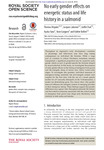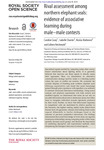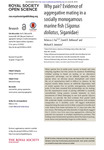Search
Now showing items 11-20 of 144
Signalling with a cryptic trait
(2016)
Sexual signals often compromise camouflage because of their conspicuousness. Pigmentation patterns, on the contrary, aid in camouflage. It was hypothesized that a particular type of pattern—barred plumage in birds, whereby ...
The importance of delineating networks by activity type in bottlenose dolphins (Tursiops truncatus) in CedarKey, Florida
(The Royal Society, 2015)
Network analysis has proved to be a valuable tool for studying the behavioural patterns of complex social animals. Often such studies either do not distinguish between different behavioural states of the organisms or simply ...
No early gender effects on energetic status and life history in a salmonid
(2015)
Throughout an organism’s early development, variations in physiology and behaviours may have long lasting consequences on individual life histories. While a large part of variation in critical life-history transitions ...
Rival assessment among northern elephant seals
(The Royal Society, 2015)
Specialized signals emitted by competing males often convey honest information about fighting ability. It is generally believed that receivers use these signals to directly assess their opponents. Here, we demonstrate an ...
Object localization using a biosonar beam
(The Royal Society, 2015)
Determining the location of a sound source is crucial for survival. Both predators and prey usually produce sound while moving, revealing valuable information about their presence and location. Animals have thus evolved ...
Self organized flexible leadership promotes collective intelligence in human groups
(The Royal Society, 2015)
Collective intelligence refers to the ability of groups to outperform individual decision-makers. At present, relatively little is known about the mechanisms promoting collective intelligence in natural systems. We here ...
Greater magnocellular saccadic suppression in high versus low autistic tendency suggests a causal path to local perceptual style
(The Royal Society, 2015)
Saccadic suppression—the reduction of visual sensitivity during rapid eye movements—has previously been proposed to reflect a specific suppression of the magnocellular visual system, with the initial neural site of that ...
Why pair? Evidence of aggregativemating in a sociallymonogamous marine fish
(The Royal Society, 2015)
Many species live in stable pairs, usually to breed and raise offspring together, but this cannot be assumed. Establishing whether pairing is based on mating, or an alternative cooperative advantage, can be difficult, ...
Teaching in hunter– gatherer infancy
(2016)
A debate exists as to whether teaching is part of human nature and central to understanding culture or whether it is a recent invention of Western, Educated, Industrial, Rich, Democratic cultures. Some social–cultural ...
Omura’s whales off northwest Madagascar
(2015)
The Omura’s whale (Balaenoptera omurai)was describedas a new species in 2003 and then soon after as an ancient lineage basal to a Bryde’s/sei whale clade. Currently known only from whaling and stranding specimens primarily ...










